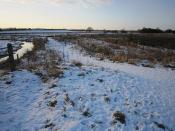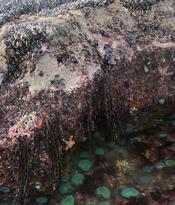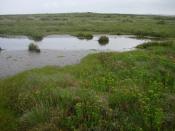Water Biomes
Marshland is covered with grasses, reeds, sedges, and cattails. These plants all have their
roots in soil covered or saturated with water and its leaves held above water.Marshes may
be freshwater or salt. Freshwater marshes develop along the shallow edges of lakes and
slow-moving rivers, forming when ponds and lakes become filled with sediment. Salt
marshes occur on coastal tidal flats. Inland salt marshes occupy the edges of lakes. They
affect the supply of nutrients, the movement of water, and the type and deposition of
sediment.
Salt marshes are best developed on the Atlantic coasts of North America and
Europe. In eastern North America the low marsh is dominated by a single species, salt-
marsh cordgrass. The high marsh consists of a short cordgrass called hay, spike grass, and
glasswort. Glasswort is the dominant plant of Pacific Coast salt marshes.
Freshwater marshes provide nesting and wintering habitats for waterfowl and
shorebirds, muskrats, frogs, and many aquatic insects.
Salt marshes are wintering
grounds for snow geese and ducks, a nesting habitat for herons and rails, and a source of
nutrients for estuarine waters. Marshes are important in flood control, in sustaining high-
water tables, and as settling basins to reduce pollution downstream. Despite their great
environmental value, marshes are continually being destroyed by drainage and filling.
Marine Life, plants and animals of the sea, from the high-tide mark along the
shore to the depths of the ocean. These organisms fall into three major groups: the
benthos, plants such as kelp and animals such as brittle stars that live on or depend on the
bottom; the nekton, swimming animals such as fishes and whales that move
independently of water currents; and plankton, various small to microscopic organisms
that are carried along by the currents.
Shore Life, the essentially...


